
Daniele Papuli
Maglie (LE), 1971
“Nomen Omen”, the Latins used to say: in the name of a person is enclosed their destiny. This is the case of the Salento artist Daniele Papuli because of the singular assonance of his name with the Spanish ”papel” which means “paper” and with the French “papier”. The artist comes to the manipulation of paper making it the fulcrum and the means of his expressive language after an approach to sculpture with a series of early artifacts in stone, wood, plaster.
A research path marked by the continue evolution from gravity to the lightness of form, from the solidity of the classical materials of sculpture to others of greater ductility and lightness. In 1993 in Berlin, during an international workshop, he learns the methods of making paper sheets. Since 1995 Papuli has picked paper as his material of choice: from blank sheets to printed pages of old books, telephone directories, typographical waste, scraps, cuttings, shapes that the artist assembles, cuts, thins, digs.
In his experiments, paper is transformed from cellulose mixed with soild, herbs and colors, almost impalpable, to layered matter. Stimulated mostly by the accumulation and juxtaposition of reams in strips and cuttings, the artist transforms paper into a malleable plastic material. The sheet of paper becomes a unit of measurement of complex architectures, for volumes that open and disclose, animated by an internal dynamism.
The innate weakness of paper is put to the test by the creative process of the artist who, with the manual skill of the sculptor, knows how to extrapolate the form by juxtaposing hundreds and often thousands of modules. The paper monoliths are now precious organisms with natural and delicate shapes, surreal, endowed with an unusual vitality that trap the iridescent chromatic nuances of light and shadow.
In the same way, other materials, investigated for their expressive potential, undergo this process of reduction into slender and multiple units. Strips of wood, vinyl sheets, polypropylene straps, frayed polyester ribbons are juxtaposed, overlapped, interwoven, sewn, in a continuous process of transformation, which leads Papuli to continuous encroachments in different areas: from architecture to fashion, from furniture to stage sets for exhibitions, fairs and international exhibitions.
A continuous dialogue with space, places and materials. The installations become open spatial constructions. Paper is transformed into vibrant, changeable matter and is brought back to the origin of an archetypal form. The forms become fluid in modular structures composed of thousands of strips that stretch out on the floor sliding from one room to another as in the exhibition Metamorphosis in the Palazzo Ducale in Martina Franca (TA) in 2014, or as magmatic infiltrations that cling to the walls, vertically, on the four floors of the building, as in the project The Blue Ribbon for House of Peroni in London in 2014. In the same way, meters of polyester webbing are manipulated and frayed by hand, reduced to a thread, brought back to the origin of their own composition and descend either in volutes immersed in light, as in the installation Mise en mpise realized for Dilmos in Milan in 2013 on the occasion of the FuoriSalone, or suspended as voluminous circular tapestries that dance in space as in Poil Pois Appeal at the Flux Laboratory in Geneva in 2011. At other times the artist prefers to draw the space with small segments of bamboo building impalpable grids as in the installation Uff, for the opening of MUBA, the Museum of the Child in Milan, in 2012, at the Rotonda della Besana.
Recently, important personal exhibitions have been dedicated to him: VIS-à-VIS. Carte sculture, curated by Luciano Caramel, at the Fondazione Calderara di Vacciago di Ameno (Novara) in 2010, Les géants de papier. Projections de la matiére at the Flux Laboratory in Geneva in 2011. In the same year, Scultografie, installazioni e sculture at Castello Aragonese in Ischia and Metamorphosis. Sculptures and paper installations at the Palazzo Ducale in Martina Franca (TA) in 2014.
On the occasion of the 2016 edition of the Salone del Mobile, the artist was invited, for the experimental project DoppiaFrirma, to create an exclusive collector’s piece, in collaboration with the famous Milanese architect and designer Michele de Lucchi, which was exhibited, from April 12 to 17, one of the most prestigious institutions of the Lombard capital: the Biblioteca Ambrosiana.
(Guendalina Belli)
Works
-
 Intondo Lux, 5/GVR
Intondo Lux, 5/GVRLAMELLAR INLAYED STRUCTURE WITH STRIPS OF FORMOSA GIALLO, GIALLO SOLARE AND AZZURRO CARDBOARD GR. 140, CUT BY HAND
-
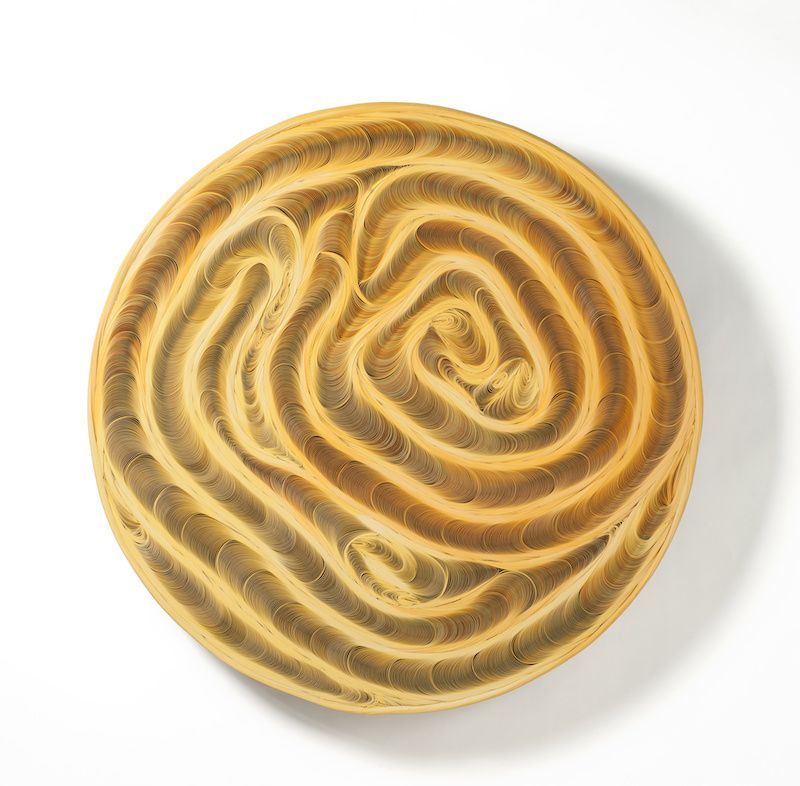 Intondo giallo 4CV, 2018
Intondo giallo 4CV, 2018LAMELLAR VOLUME MADE BY INLAYING STRIPS OF FORMOSA GIALLO AND GIALLO SOLARE CARDBOARD GR. 250, CUT BY HAND
-
 Centrica 2B
Centrica 2BLAMELLAR STRUCTURE MADE BY INLAYING STRIPS OF INVERCOTE WHITE CARDBOARD GR. 260, CUT BY HAND
-
 Cartangolo 9M
Cartangolo 9MLAMELLAR VOLUME COMPOSED OF STRIPS OF FORMOSA GREY CARDBOARD GR. 220 AND POLYCHROME PAPERS OF VARIOUS TYPES, CUT BY HAND
-
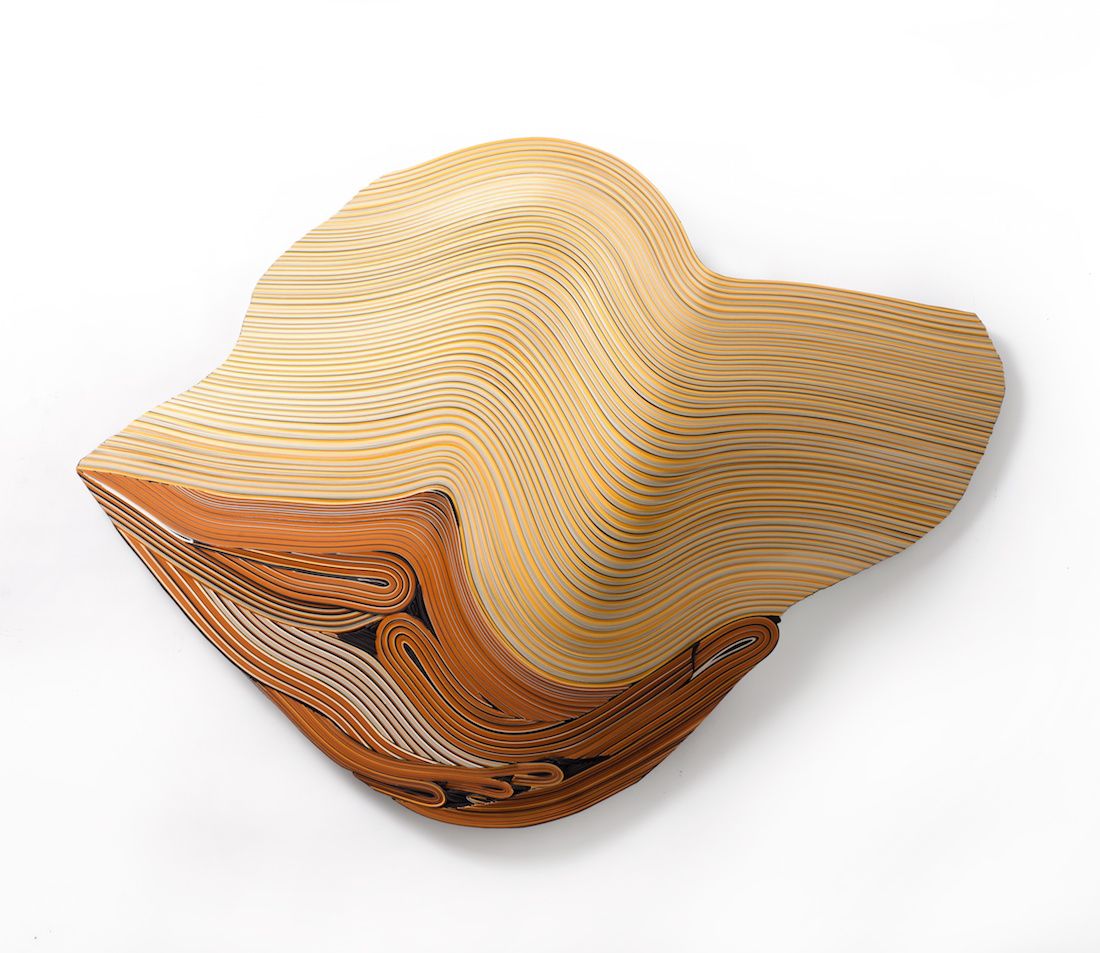 Cartangolo 10M
Cartangolo 10MLAMINATED VOLUME COMPOSED OF STRIPS OF FORMOSA YELLOW, SUEDE, GREY AND BLACK CARDBOARD GR. 140 WITH POLYCHROME INLAY OF SELECTED PAPERS OF VARIOUS TYPES PAINTED WITH COLORED ANILINE AND CUT BY HAND
-
 Cartangolo 11M
Cartangolo 11MLAMINATED VOLUME COMPOSED OF STRIPS OF FORMOSA GREY AND BLACK CARDBOARD GR. 140 WITH POLYCHROME INLAY OF SELECTED PAPERS OF VARIOUS TYPES PAINTED WITH COLORED ANILINE AND CUT BY HAND
-
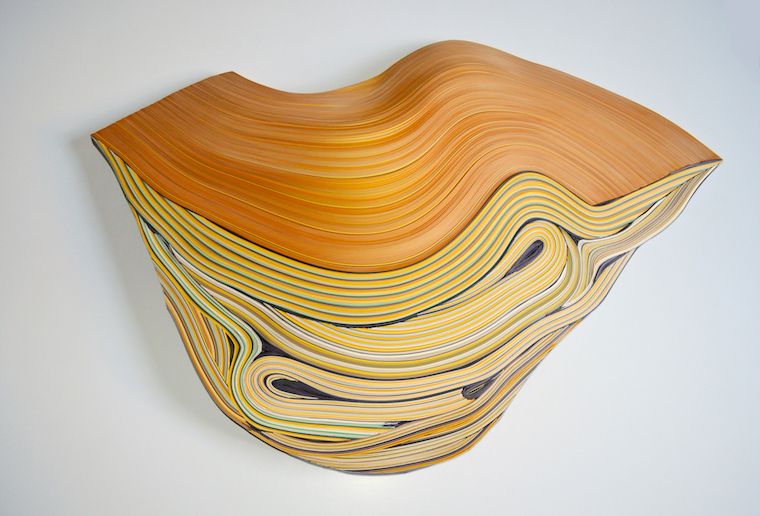 Cartangolo 12M
Cartangolo 12MLAMELLAR VOLUME COMPOSED OF STRIPS OF CARDBOARD FORMOSA CHAMOIS, YELLOW, SOLAR YELLOW, BLACK GR. 140, PAINTED WITH COLORED ANILINES AND CUT BY HAND
-
 Intondo nero/R
Intondo nero/RLAMELLAR VOLUME MADE BY INLAYING WITH STRIPS OF FORMOSA BLACK CARDBOARD GR. 140 AND INSERTS IN STRIPS OF LANILLA RED GR. 250, SHAPED AND CUT BY HAND
-
 Aura rossa R/1
Aura rossa R/1LAMELLAR VOLUME OF TRUNCATED CONE SHAPE COMPOSED OF 1200 MODULES OF PAPER CORDENONS RED VERMILLON GR. 165, SHAPED AND CUT BY HAND
-
 Cartangolo 6M
Cartangolo 6MLAMELLAR VOLUME COMPOSED OF STRIPS OF CARDBOARD CORDENONS CHAGALL SAND GR. 260, WITH POLYCHROME INLAY, SHAPED AND CUT BY HAND
-
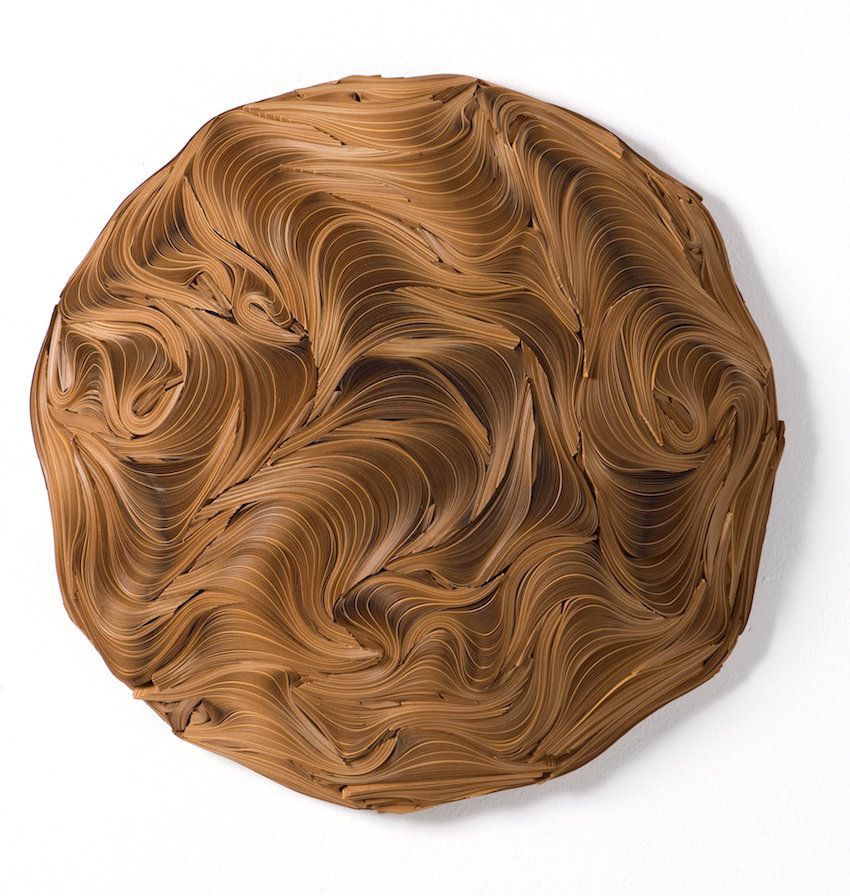 Intondo 2OP
Intondo 2OPLAMELLAR INLAY STRUCTURE MADE WITH STRIPS OF TOBACCO INGRES PAPER GR. 90, SHAPED AND CUT BY HAND
-
 Intondo 10P
Intondo 10PLAMELLAR INLAY STRUCTURE MADE OF STRIPS OF INGRES ASH PAPER GR. 190, SHAPED AND CUT BY HAND
-
 Intondo rosa
Intondo rosaLAMELLAR VOLUME MADE INLAY WITH SCRAPS OF WHITE CARDBOARD PRINTED IN RED
-
 Intondo Arches
Intondo ArchesLAMELLAR VOLUME MADE WITH STRIPS OF ARCHES AQUARELLE CARDBOARD GR. 185 AND DARK GREY CARDBOARD INSERTS, SHAPED AND CUT BY HAND
-
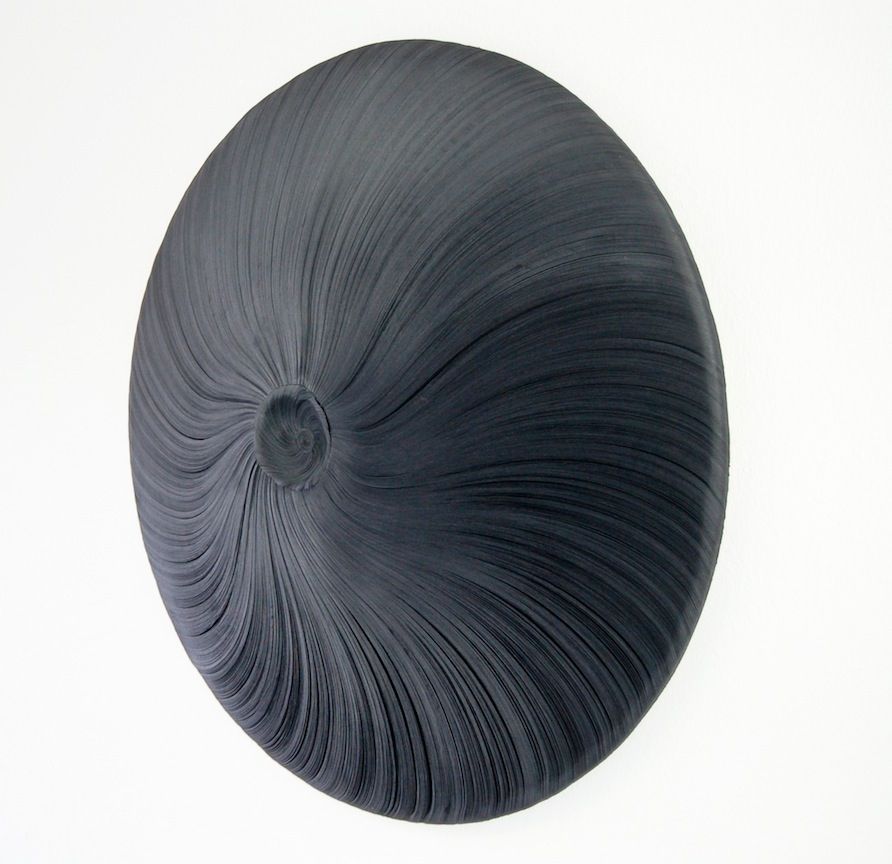 Intondo nero
Intondo neroLAMELLAR VOLUME OF CONVEX SHAPE COMPOSED OF 1000 MODULES OF CORDENONS MALMERO NOIR PAPER GR.120, SHAPED AND CUT BY HAND
-
 Sibilla
SibillaLAMELLAR VOLUME OF OVOIDAL SHAPE COMPOSED OF 960 MODULES OF PAPER, SHAPED AND CUT BY HAND, OF TWO TYPES: CORDENONS ICELITE GR. 200 AND INGRES, GRAY COLOR GR. 200.
-
 Sibilla Bianca W/1
Sibilla Bianca W/1LAMELLAR STRUCTURE OF SPHERICAL SHAPE COMPOSED OF 960 MODULES OF SOPORSET WHITE CARDBOARD GR. 250, SHAPED AND CUT BY HAND
-
 Sibilla Blu B/1
Sibilla Blu B/1SPHERICAL LAMELLAR STRUCTURE MADE UP OF 960 MODULES OF CORDENONS ABYSSE CARDBOARD GR. 250, SHAPED AND CUT BY HAND
-
 Euritmetrica
EuritmetricaVARIABLE SIZE INSTALLATION, SEMI-CYLINDRICAL STRUCTURES MADE OF STRIPS OF CORDENONS ICELITE PAPER GR 120
-
 Nerometría
NerometríaLAMINATED VOLUME COMPOSED OF PAPER FORMS, TELEPHONE DIRECTORY PAGES AND YELLOW PAGES, SHAPED AND CUT BY HAND
-
 Nerometria
NerometriaLAMELLAR VOLUME COMPOSED OF PAPER MODULES, USED BOOK PAGES, SHAPED AND CUT BY HAND
-
 Tursu 2-I
Tursu 2-ILAMELLAR STRUCTURE COMPOSED OF STRIPS OF CORDENONS ICELITE PAPER GR. 120, SHAPED AND CUT BY HAND AND LIGHT ALUMINUM INSERTS
-
 Turso 6 BO
Turso 6 BOLAMELLAR STRUCTURE COMPOSED OF STRIPS OF SELECTED PAPERS OF VARIOUS TYPES AND WEIGHTS, CUT BY HAND
-
 Turso 7 RN
Turso 7 RNLAMINATED STRUCTURE COMPOSED OF STRIPS OF WHITE CARDBOARD WITH RED PRINTING MARK AND INSERTS IN BLACK FORMOSA CARDBOARD GR. 140, CUT BY HAND
-
 Turso 5 GBN
Turso 5 GBNLAMELLAR VOLUME MADE WITH STRIPS OF PAPER SELECTED FOR COLOR AND WEIGHT, SHAPED AND CUT BY HAND
-
 Intondo 1/CDS24
Intondo 1/CDS24LAMELLAR VOLUME COMPOSED OF STRIPS OF NEWSPRINT AND LIGHT WEIGHT PAPER IN BLACK AND IVORY, SHAPED AND CUT BY HAND
-
 Intondo 2/CDS24
Intondo 2/CDS24LAMELLAR VOLUME COMPOSED OF STRIPS OF NEWSPRINT AND LIGHT WEIGHT PAPER IN BLACK AND IVORY, SHAPED AND CUT BY HAND